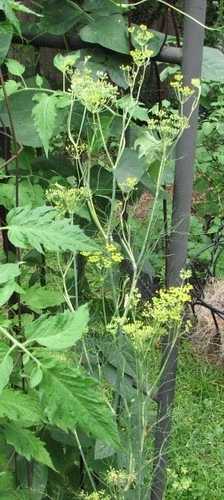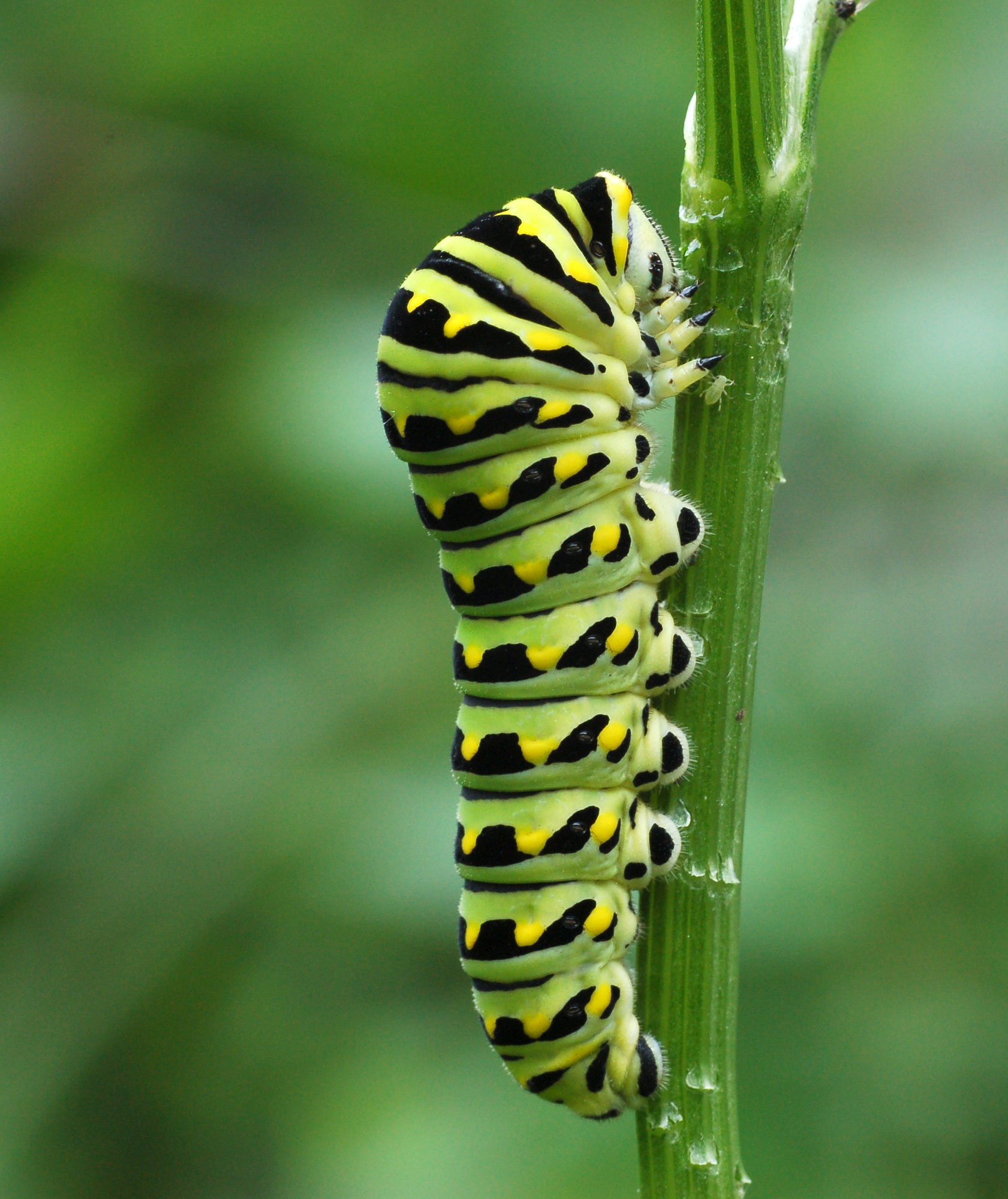How to Use Fennel (or Dill) to Keep Caterpillars Off Your Vegetable Plants
I don’t do a lot of companion planting. I’m not saying it doesn’t work (and I’d love to hear your success stories) but other than being impressed by mycorrhizal fungi and permaculture plant guilds I haven’t felt the need to find my plants a buddy.
Oh! EXCEPT for growing fennel next to plants plagued by caterpillars. Flowering fennel is like a beacon for caterpillar-eating wasps. Think of veggie-munching caterpillars as the bad guys, the wasps as Batman, and fennel as the bat signal. Here they come to save the day!
(Okay yeah, if I distressed your geek-meter I do know that last bit came from Mighty Mouse).

Photo Caption: Fennel blooms are a beacon for beneficial wasps. Plant them next to crops that have caterpillar pests and watch the wasps carry away the offending larva. My tomatoes and fennel in this photo worked well together – I saw no tomato hornworms all season. Dill is a close relative of fennel and will work equally well.
(Much to my insect-loving daughter’s chagrin) I haven’t dealt with tomato hornworms for several years now. Since I know they are in my neighborhood I attribute the lack of them in my garden to the row of fennel next to the tomatoes and the catalpa tree harboring tons of catalpa sphinx moth caterpillars. Since these two moths are related the catalpa hornworms are a breeding ground for high numbers of their predators.
When the fennel is blooming you can sit next to it and watch the wasps come in. Tiny parasitic wasps love the nectar-filled blooms but it also alerts larger predatory wasps. If wasps discover caterpillars in the area they quickly take advantage of this high-protein food.
You may be surprised but social wasps like yellow jackets and hornets are excellent garden guards. If their nest isn’t close by they aren’t interested in stinging you. They can clean out a caterpillar infestation in a matter of minutes — I’ve watched them do it! A hunting wasp will take a caterpillar back to its nest and then alert its roommates where the tasty larva was found. The other wasps go (like an army of flying monkeys) to collect the rest of the caterpillars. An hour later your plant is free of pests!
Parasitic wasps are also effective but the results are less obvious. Caterpillars that have had eggs laid inside them may continue feeding for a brief period but inevitably they will die. If you see rice-like cocoons pop up on the back of a caterpillar you can be sure its life is nearly over. Don’t destroy the cocoons! They will hatch into adult parasitic wasps that keep the cycle going.
The trickiest part is that you have to keep the flowers pruned when they begin to form seeds or the insects won’t come!
Fennel is gorgeous in the garden and the umbels of blooms seem to last forever… but it is misleading! Once the sticky, nectar-rich, pollen-sprinkled flowers start to elongate and take on a matte appearance they are actually immature seeds. These photos of undeveloped fennel seeds (taken by Anna at the Flower Garden Girl blog) show what you should prune off. Once they are at this stage by all means take them indoors to enjoy — then your plant will make the effort to flower again and attract more insects.
This is what fennel blooms look like before they start forming seeds:

Photo Caption: Fennel blooms like these attract insects until they start to go to seed. When they lose their petals and start to elongate you should clip them off. Your plant will make more.
This is also useful information if you are a butterfly gardener and you want to keep your caterpillars safe. If you don’t want wasps to carry away the black swallowtails eating your fennel, clip off the blooms the moment the blossom stalks appear. If you never let it flower you will reduce the number of wasps visiting your garden.

Photo Caption: This black swallowtail caterpillar eats fennel and turns into a popular butterfly. If you are butterfly gardening it is best to put your host plant fennel farther away from your vegetable crops so that you won’t mind cutting off the flowers.

Photo Caption: Black swallowtail butterflies are a common garden visitor. The caterpillars eat fennel and other plants in the same family, such as parsley.
I love fennel! You can also eat the stalks of bronze fennel (like you would bulbing fennel) or you can use the seeds in curries and other recipes.
It makes a stunning ornamental — especially the bronze variety. I like to cut the feathery leaves to use as filler in heirloom rose bouquets.
If you’d like to get started with fennel near your veggies this year, you can buy the bronze or green variety. Bulbing fennel also blooms and serves a dual purpose as a tasty vegetable!
Alternately, you can use other members of the carrot family. Dill is the best choice, the wasps like it equally as well as fennel. Unlike fennel, (a perennial), dill is an annual, so it may be a better choice if you plan to completely empty your vegetable garden beds at the end of the season. Other options are Queen Anne’s Lace, cilantro, caraway, and parsley. Note that parsley is not as free blooming as the others and the flowers are what appeals to the insects you want.
22 thoughts on “How to Use Fennel (or Dill) to Keep Caterpillars Off Your Vegetable Plants”
Comments are closed.

Liza - March 5, 2010 3:05 pm
I think this post is plantastic! I had no idea about wasps being garden guards, that’s so cool!
Sustainahillbilly
Twitter: appalachianfeet
- March 5, 2010 6:01 pm
Thanks! Yeah, I thought about them a lot more positively once I watched them clean cabbageworms off my broccoli one year. I’ve seen them clean up various crops since then.
Crafty Gardener - March 5, 2010 7:24 pm
Very interesting post about fennel. I have grown it in my garden before.
Did you know the tomato horn worm caterpillars turn into clear wing hummingbird moths?
Sustainahillbilly
Twitter: appalachianfeet
- March 11, 2010 1:37 pm
Thanks! I love those hummingbird clearwing moths, although for me the caterpillars eat viburnums. They are in the sphinx/hawk moth family which is the same family the tomato hornworm is in.
It could just be a common name thing, though. A lot of times I’ve found that I called an insect or plant one name in my region but that name is used for a different species in another area of the country. I think what people call “granddaddy long legs” is a different species entirely depending on where you live.
Either way, they are both really pretty and similar moths! (A rose by any other name…)
Hummingbird Clearwing http://www.silkmoths.bizland.com/hthysbe.htm
Tomato Hornworm/5-Spotted Hawkmoth http://www.silkmoths.bizland.com/mquinqui.htm
I’ve actually raised a Snowberry Clearwing moth, which ate honeysuckle. It was so neat to watch it come out of its pupa:
http://www.butterfliesandmoths.org/species?l=3439
Anna - March 6, 2010 9:02 am
I knew fennel attracted beneficial insects, but that’s all I knew. So my fennel technique has been hit or miss — I plant them and ignore them. Now I’ll know how to maximize my wasp population — thank you!!
Also, now I finally understand why the Black Swallowtails — which I’d never seen before in my life — have been in my garden the last two summers….
Sustainahillbilly
Twitter: appalachianfeet
- March 11, 2010 1:23 pm
I was so excited when I found out I could bring in the finished blooms as bouquets and it would help out my garden. Congratulations on having black swallowtails now!
Ginny - March 6, 2010 10:36 pm
Great post on fennel. I learned to identify swallowtail caterpillars because my fennel was covered with them. I loved the butterflies that appeared later! I used the fennel blooms with other cut flowers.
Sustainahillbilly
Twitter: appalachianfeet
- March 11, 2010 1:24 pm
That sounds so pretty! I think the leaves make the best filler with bouquets, too!
Jean
Twitter: JeanDigGrowComp
- March 10, 2010 10:41 pm
I’ve also seen my garlic chives attract the same wasps. But I never thought about the fact that they were helping other plants. One time I was lucky enough to watch a yellow jacket attack a big caterpillar. I knew for sure they were worth having around after that!
Sustainahillbilly
Twitter: appalachianfeet
- March 11, 2010 1:25 pm
I think most of the umbel-type flowers are attractive to small wasps. I have some garlic chives so I’ll have to look out for that this year when it is blooming.
Pingback: How to Grow Vegetables (Archive Directory) | Appalachian Feet
Anna Flowergardengirl™ - June 20, 2010 12:01 am
Thank you for the link and this is a very nicely written article about fennel. I do love the flowers and my bronze fennel is flowering right now.
.-= Anna Flowergardengirl™´s last blog ..Blessed are the organic gardeners for they attract bees =-.
Wasp Catcher - January 26, 2011 7:09 pm
I can easily believe that wasps can be garden guards since they really eat insects that eat plants. This is why they are seen as beneficial to farmers. But what do you do about your children? How do you keep them from getting stung?
Sustainahillbilly
Twitter: appalachianfeet
- June 14, 2011 10:16 am
I’ve found that unless I’m poking at a foraging wasp, it isn’t interested in me (or my daughter). It’s a different story if you invade the area their nest is located, but most wasps are far from home when they visit your garden.
Sustainahillbilly´s last blog post ..How to Miss 21 Chickens Even if They Were Living in Your Kitchen
Pingback: How to Identify Pests and Control them Naturally with Beneficial Bugs, Trap Crops, and More | Appalachian Feet
Busy Bee - June 4, 2013 2:58 pm
I just had a great experience with Fennel. I have a very small backyard and I planted lots of tomatoes. Because I also like Fennel I planted a row a Fennel between Tomatoes. I was watering the plants when in horror I discovered there where caterpillars there. I started checking the Tomatoes plants and surprisingly there were not there. They were ALL in the Fennel plants, so it was very easy to pick them one y one, since the Fennel has very thin leaves. It worked as a magnet for Caterpillars. Did not know that.
Eliza Lord
Twitter: appalachianfeet
- June 5, 2013 10:25 am
Your fennel caterpillars will turn into black swallowtail butterflies, which are different than tomato hornworms. However, their feeding may prompt your plants to flower more in order to alert predatory wasps in the area.
Eliza Lord
Twitter: appalachianfeet
- February 9, 2015 2:53 pm
I’m sure the caterpillars loved your fennel, but those are black swallowtail butterfly caterpillars. That species eats members of the carrot family like fennel, dill, and parsley but it doesn’t eat members of the nightshade family like tomatoes. The big caterpillars that attack tomatoes are tomato hornworms, which turn into a moth in the sphinx/hawkmoth family. Most likely the lack of caterpillars on your tomatoes was due to all the beneficial predatory wasps you attracted — one of their favorite foods are sphinx moth family caterpillars.
Pingback: How to Learn About Permaculture | Appalachian Feet
carol t. moore - June 27, 2014 2:14 pm
thanks
Cee_Food - February 9, 2015 12:03 pm
So if I pick off the caterpillars from the fennel can I move them to a distant clump of fennel on my property without them returning?
Eliza Lord
Twitter: appalachianfeet
- February 9, 2015 2:46 pm
That should work while they are still caterpillars. As adults, the butterflies won’t eat the fennel but they might come lay more eggs on it. You can keep moving them, though.